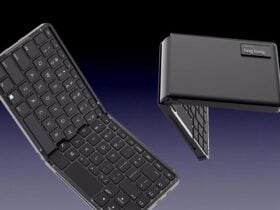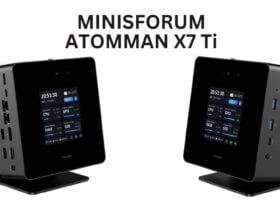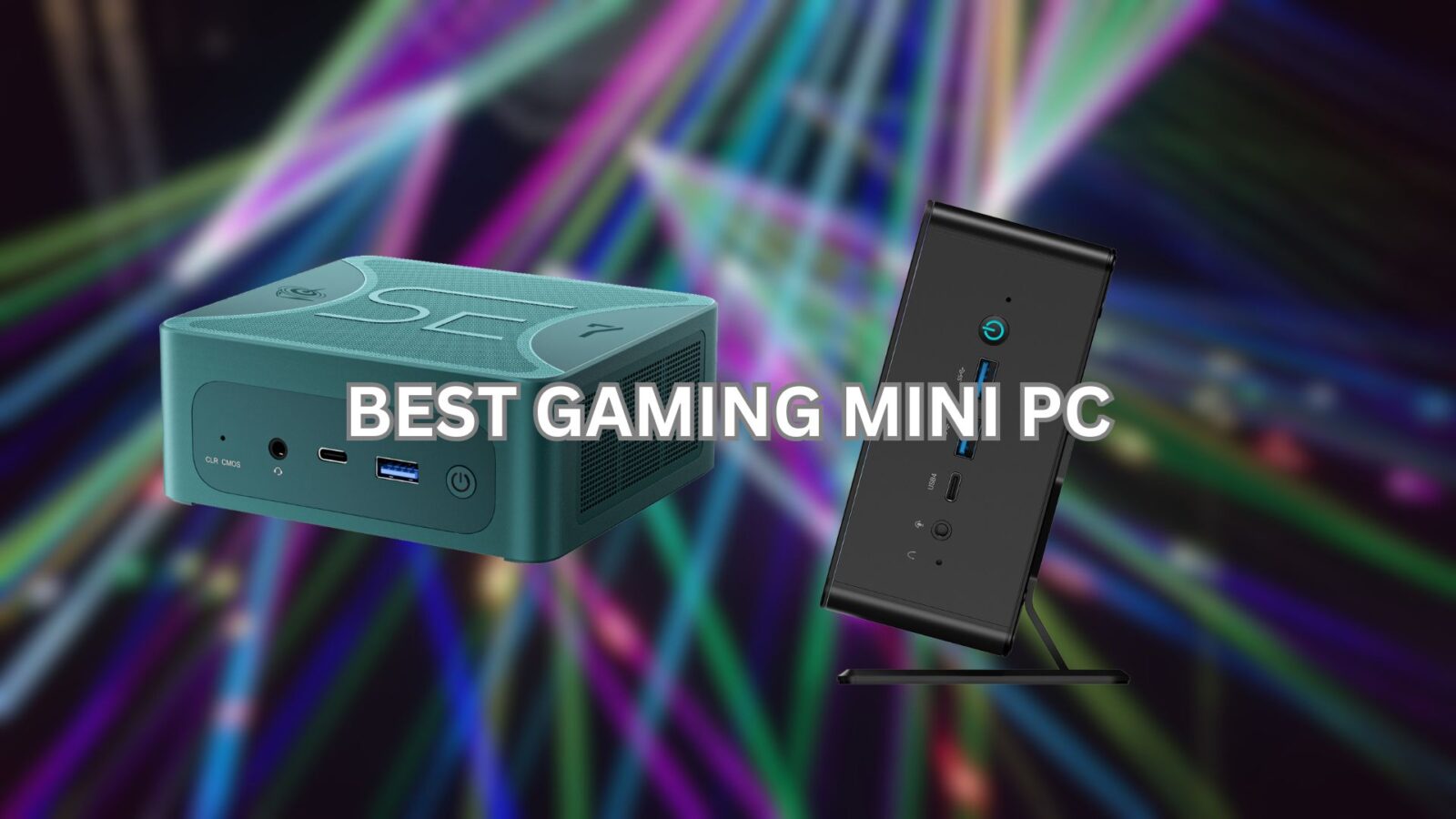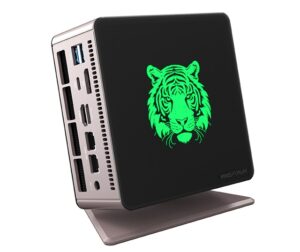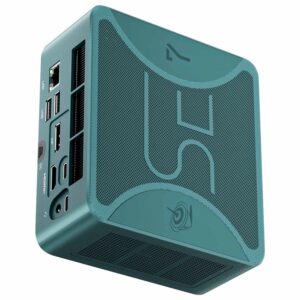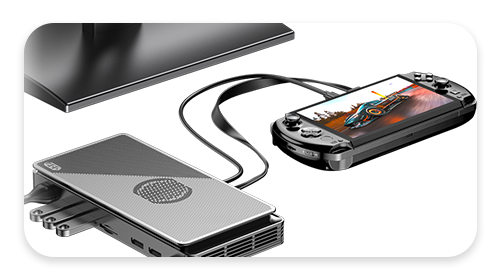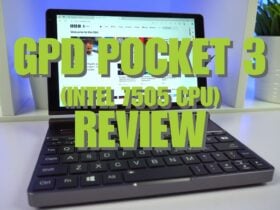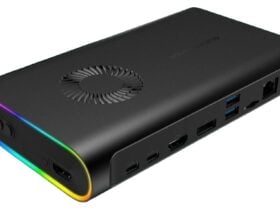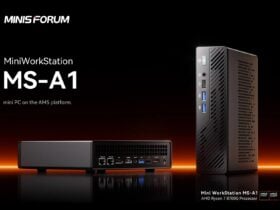Need a gaming PC, but don’t have room for a bulky tower? Want to game in the comfort of your living room without an eyesore of a monolith taking up valuable visual real estate? You might just be interested in a gaming mini PC. But what is a gaming mini PC, you ask? Read on to find out.
The Best Gaming Mini PCs Are Updated!
Traditionally, when you think of a gaming PC, what comes to mind? Is it an ornate, glass-panelled sculpture, brimming with flashing LED lights and dubiously-necessary air intakes?
How about a hulking, matte black monolith that emits an ever-present ominous hum? Heavy enough so that specialized lifting techniques are required to move it around? Would you believe us if you said this is no longer (necessarily) the case anymore?
Thanks to advancements in technology, it’s fully feasible to have a fully-fledged gaming PC that’s somehow even smaller than a console. We’ll go over how this is possible, and more, in this article.
Need a mini PC that isn’t quite for gaming? Check out our broader selection of mini PCs here!
What is a Gaming Mini PC?
The “gaming mini PC” we’ll be going over in this article is a subset of the “mini PC” style of devices that have risen to popularity in the late 2010s.
A mini PC is, at its core, simply a regular PC in a smaller package (hence the “mini” prefix). These are specialized computers built on a motherboard that is much, much smaller than one would find in a regular PC.
Even in comparison to the microATX standard, mini PCs are by far and away a much more practical option for those looking to optimize what little space they have available in their setup.
The components of a Gaming Mini PC
Much like a regular PC, a mini PC has a handful of core components that are critical to functioning. Unlike a regular PC however, many of these core components are embedded directly into the motherboard.
Primarily, this would be the CPU. Which is soldered directly onto the motherboard as a way of further saving space (as the mechanisms required for an exchangeable CPU increase the minimum possible size by a fair margin.
On some mini PCs, the RAM and even the storage can be embedded directly into the motherboard. This is typically only seen in more budget models, however, wherein embedded memory and storage are more cost-efficient to implement.
Beyond that, you’ll need the same peripherals as you would on a gaming PC. Including a display (anything that goes by the name of a “gaming mini PC” supports 4K displays, if you use those), mouse, keyboard, speakers, and other miscellaneous items.
Are Gaming Mini PCs more powerful?
This is an easy one to answer. Compared to other mini PCs, yes, they are! Gaming mini PCs leverage the latest processors with high throughput to provide high visual fidelity and fast framerates in numerous games. From the old to the new.
Compared to regular gaming PCs, however, the answer is often no. The trade-off in size one gain from a mini PC is offset by a limit in the performance of the components it can accommodate. However, we are now seeing gaming mini PCs with graphics cards inside of them such as a Nvidia GeForce 3070 which is comparable to a desktop PC.
This is because the small size of the device is very counter-productive to “heat efficiency”, therefore lower-power components (or regular components configured to run at lower frequencies) are commonplace among even the best gaming mini PCs.
That’s not to say that they are not viable for gaming. However, the performance you’ll get out of a top-end mini PC simply will not be able to compare to that of a high-end gaming PC that can slot the latest dedicated GPUs, high-TDP processors, and more without any discomfort.
Conversely, however, a high-end PC in the current market is a difficult thing to put together. Primarily due to the heavy premium being charged for dedicated graphics cards. So if you’re going to commit to a gaming PC (instead of waiting), why not “trim the fat” and opt for a mini-gaming PC?
The Advantages of a Gaming Mini PC
The first and foremost concrete advantage of a gaming mini PC (over a regular mini PC) is it’s size. If you’ve been following our blog for any length of time, you’ll likely see the size of a mini PC as the central benefit of any device hailing from this paradigm. This rings just as true for the gaming mini PC as it does for all others.
Without a large, bulky tower take up space on your desk. You will naturally have more room for other peripherals, or will just have a cleaner desk overall. It also means you are not as constrained by space limitations (i.e., if you have what is essentially a small closet’s worth of space, it’s not a problem with a gaming mini PC).
The second advantage of a gaming mini PC, and one that is a little less obvious, is the savings you make in power consumption. You see, most mini PCs make use of mobile processors which, while slightly lower in raw power, are more power efficient than a regular PC.
The result is that you’ll have a PC that doesn’t eat into your energy bills as much! Which is a nice benefit given rising energy prices as of late.
The third advantage of a gaming mini PC that you’d do well to consider is its ease of use. With few individual components to concern yourself with, the overhead knowledge-wise of a gaming mini PC is quite small. Even if you’re not very tech-savvy, it is not too complex to upgrade/change the RAM and storage to your desired capacities.
Why should I buy a gaming mini PC?
In our opinion, the best reason to buy a gaming mini PC is to use it as a core of a media centre in your living room or a similar communal location, such as a lounge for a youth centre, or perhaps even a hospital.
The ease of setting up and lack of space required make gaming mini PCs a perfect fit for these environments, where larger tower computers may not be as suitable – either due to aesthetic issues or practical issues (i.e., you generally don’t want large sensitive equipment in shared spaces).
If you’re looking for something to throw under your TV, or as an easy-to-set-up workhorse mini PC to use in the home office, look no further than a gaming mini PC, as their high performance extends not just to gaming, but for general productivity tasks as well.
What are the Best Gaming Mini PC’s?
DroiX has gathered some of the best gaming mini PCs available to buy today. With such a variety on offer, you’re sure to find one that suits your needs in earnest!
Let’s take a look at the gaming mini PCs we will be covering in detail below, comparisons of tech specs and benchmarks can be found afterwards
#1. MinisForum UM780 XT Gaming Mini PC
The Minisforum UM780 XTX stands out in the realm of gaming mini PCs, particularly for those keen on gaming and power in a compact form. It boasts an AMD Ryzen 7 7840HS processor with 8 cores and 16 threads, reaching up to 5.1 GHz, alongside an AMD Radeon 780M GPU. This powerhouse is complemented by dual-channel DDR5 RAM that supports up to 96GB at 5600MHz and two M.2 2280 PCIe4.0 SSD slots for storage.
For connectivity, the Minisforum UM780 XTX includes Wi-Fi 6E, Bluetooth 5, dual 2.5Gbps Ethernet ports, and a variety of video and audio outputs, including HDMI 2.1, DP 1.4, and USB4 ports. Running on Windows 11, it’s designed for efficiency and speed, measuring just 5.11 x 5.11 x 2.3 inches and weighing around 740g, making it an attractive option for those looking for powerful specifications in a small package.
In terms of performance, the Minisforum UM780 XTX excels across various benchmarks, indicating its capability to handle demanding tasks and games. Its system benchmarks reveal it scoring the highest in PassMark (8136.7) and PCMark (10,838) tests compared to other compact gaming PCs. Read our full Minisforum UM780M review here for the full comparison.
Gaming benchmarks further demonstrate its prowess; for instance, in Forza Horizon 5, it achieves over 60 FPS at resolutions up to 1440P on integrated graphics, and with the use of an eGPU via the Oculink port such as the GPD G1 , the Minisforum UM780 XTX leads in performance across all resolutions tested. Additionally, it shows impressive emulation capabilities, handling modern console emulations with ease, thus showcasing its versatility as a gaming machine.
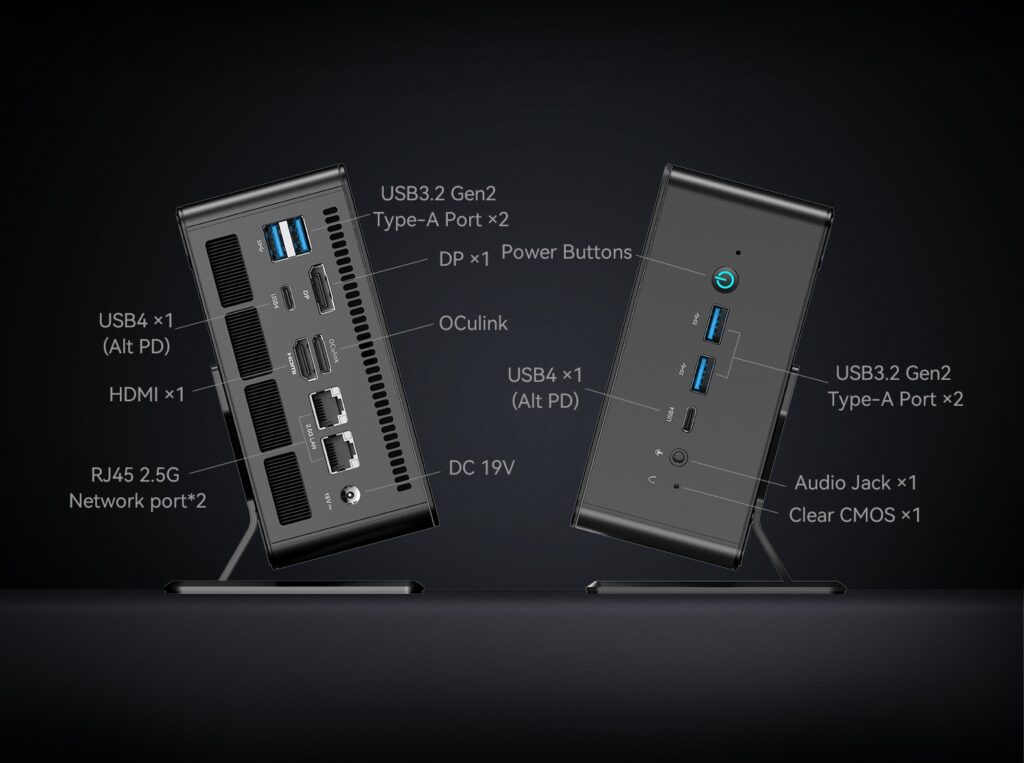
The Minisforum UM780 XTX positions itself as a compelling choice for both work and play. Its compact size does not compromise its performance, making it suitable for a variety of scenarios from office work to gaming.
Its ability to seamlessly transition between a high-performance work machine and a powerful gaming PC, especially when paired with an eGPU, sets it apart from other mini PCs. Despite some criticisms about its aesthetic choices, such as the LED lighting and etched design, its overall performance and portability make it an excellent investment for those seeking a mini PC that does not sacrifice power for size. Whether for professional use, gaming, or emulation, the Minisforum UM780 XTX proves to be a top contender, offering a blend of versatility, power, and convenience.
#2. Beelink SER7 Gaming Mini PC
The Beelink SER7 emerges as a compact yet powerful contender in the small form factor gaming PC arena, distinguished by its impressive technical specs tailored for both gaming enthusiasts and productivity users alike. At its heart lies an AMD Ryzen 7 7840HS processor, featuring 8 cores and 16 threads with speeds ranging from 3.80 GHz to 5.10 GHz, complemented by an AMD Radeon 780M GPU.
This setup is supported by 32GB of DDR5 SO-DIMM RAM and a 1TB M.2 2280 PCIe 4.0 SSD, ensuring swift and responsive performance. Connectivity options are robust, with WiFi 6, Bluetooth 5.2, and 2.5Gbps Ethernet, while video outputs support up to quad displays, offering versatility for various setups. Despite its compact size, measuring just 4.9 x 4.4 x 1.9 inches and weighing 652g, it doesn’t skimp on ports, featuring a mix of USB Type-C, USB 3.2, USB 2.0, HDMI, DisplayPort, and dual 3.5mm audio jacks.
In performance benchmarks, the Beelink SER7 showcases its prowess, especially in gaming scenarios. While system benchmarks like PassMark and PCMark place it slightly below its competitor, the Minisforum UM780, in specific areas possibly due to differences in RAM and storage configurations, it impressively catches up in gaming benchmarks. You can read our full Beelink SER7 review here for full comparisons
In titles such as Forza Horizon 5, Shadow of the Tomb Raider, and Call of Duty Modern Warfare III, it delivers comparable and sometimes identical scores to the UM780 across various resolutions. The Beelink SER7 3DMark scores, indicative of combined CPU and GPU performance, further underline its capability to deliver a solid gaming experience, particularly noted in integrated GPU performances across various game settings and resolutions.
The Beelink SER7 stands out not just for its gaming capabilities but also for its versatility and performance in emulation, making it an excellent choice for both gaming and productivity. Despite falling slightly short in system benchmarks compared to its peers, it compensates with its gaming performance, delivering comparable results to higher-end models.
Its compact design, coupled with strong support for emulation and the ability to handle modern gaming demands, positions it as a strong contender for those in the market for a gaming mini PC. The Beelink SER7 balances performance with practicality, offering a magnetic power connector for ease of use, and quad display support, making it suitable for a wide range of uses from gaming to professional work.
The Beelink SER7, with its competitive pricing and performance, is a compelling option for anyone looking to maximise their desk space without compromising on power or versatility. It only misses out on the top spot due to not having an OcuLink port for the best eGPU performance compared to USB 4.
Best Gaming Mini PCs compared
Technical specifications
| MINISFORUM UM780 XTX | BEELINK SER7 | |
| CPU | AMD Ryzen 7 7840HS Processor, 8 Cores/16 Threads(16M Cache, up to 5.1 GHz) | AMD Ryzen 7 7840HS Processor, 8 Cores/16 Threads(16M Cache, up to 5.1 GHz) |
| GPU | AMD Radeon 780M | AMD Radeon 780M |
| RAM | 64 DDR5 Dual channel (SODIMM Slots (Dual), Up to 5600MHz, Max 96GB) | 32GB DDR5 SO-DIMM (Dual) |
| STORAGE | 2×M.2 2280 PCIe4.0 SSD | 1TB M.2 2280 PCIe 4.0 1TB SSD |
| COMMUNICATIONS | M.2 2230 WIFI Support (Wi-Fi 6E,BlueTooth 5) 2x 2.5Gbps ethernet | WiFi 6 Bluetooth 5.2 2.5Gbps Ethernet |
| BUY | HERE | HERE |
Benchmark Comparisons
| MINISFORUM UM780 XTX | BEELINK SER7 | |
| 3DMARK TIME SPY | 3209 | 3290 |
| 3DMARK NIGHT RAID | 29063 | 28690 |
| 3DMARK FIRE STRIKE | 7585 | 7650 |
| PCMARK10 | 10838 | 7489 |
| CINEBENCH SINGLE-CORE | 1790 | 16682 |
| CINEBENCH MULTI-CORE | 1764 | 15376 |
| FORZA HORIZON (1440P) | 72 FPS | 73 FPS |
| SHADOW OF THE TOMB RAIDER (1080P) | 75 FPS | 76 FPS |
| CALL OF DUTY MODERN WARFARE III (1080P) | 71 FPS | 69 FPS |

